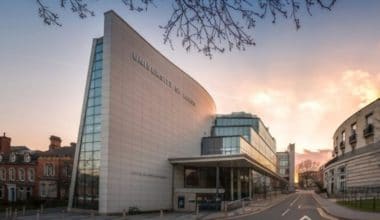Money remains a key motivating factor to consider when choosing a career path, and one question you should always ask is, how much a PharmD salary is?
Unarguably, after earning your doctor of pharmacy(PharmD) degree, what is left is to become a pharmacist. When choosing a career, there are some factors to consider: personal interests, working hours, and terms and conditions of employment.
The scope of pharmacy practice includes traditional roles such as combining and distributing medications. It also includes more modern services related to health care, including clinical services, reviewing medications for safety and efficacy, and providing drug information.
Pharmacists, therefore, are the experts on drug therapy and are the primary health professionals who optimize medication use for the benefit of the patients.
In this article, we will examine the earning potential for students who have acquired a PharmD degree and are interested in pursuing a career as Pharmacist. And also, we will examine the process of becoming one and what one can expect.
Here is a review of what you should expect in this post:
Table of contents
- What Is Pharmacy?
- Who Is A Pharmacist?
- What Is A Doctor Of Pharmacy(PharmD) Program?
- How Do I Get Into A Doctor Of Pharmacy(PharmD) Program?
- What Are The Educational Requirements And Qualifications Needed To Be A Pharmacist?
- How Do I Get Licenced As A Pharmacist?
- How Do I Get A Professional Pharmacy Job?
- How Much Should I Expect As A Doctor Of Pharmacy(PharmD Salary) Holder?
- Conclusion
- FAQs – PharmD salary
- Sources
- Editor’s Recommendation
What Is Pharmacy?
Before we begin our discussion of a PharmD salary, let’s talk about everything you need to know about this field. First, what is pharmacy?
Pharmacy is the health science that links medical science with chemistry, and it entails the discovery, production, control, disposal, and safe and effective use of drugs.
The pharmacy practice requires excellent knowledge of drugs, their mode of action, side effects, interactions, mobility, and toxicity.
Who Is A Pharmacist?
Pharmacists, also known as chemists or druggists, are health professionals who specialize in medicines. They deal with the composition, effects, mechanism of action, and proper and effective use of drugs.
What Is A Doctor Of Pharmacy(PharmD) Program?
A Doctor of Pharmacy (PharmD) is a professional doctorate in pharmacy. In some countries, it is a first professional degree and a prerequisite for licensing to practice the profession of pharmacy or to become a clinical pharmacist.
In many countries, they can practice independently and prescribe drugs directly to patients.
A PharmD graduate is entitled to prefix their name with “Dr.”
Read: What Are The Requirements For A Pharmacy School In 2024?
How Do I Get Into A Doctor Of Pharmacy(PharmD) Program?
Some pharmacy schools accept students immediately after they graduate from high school. Pharmacy schools that accept all or most students directly from high school are called “0-6” programs or early assurance programs because these students can complete their pre-pharmacy and professional study within six years after high school.
When a student applies to a “0-6” or early assurance program, he or she must meet the college’s admissions requirements. That will likely include a minimum grade point average (GPA) or SAT or ACT score.
The pharmacy program may have additional requirements. Students advance to the professional portion of the program after completing all undergraduate prerequisites.
Students who apply directly to four-year professional programs, rather than entering through a “0-6” or early assurance program, must take the PCAT, a pharmacy school entrance exam. Although not all schools require this test, many do.
Most programs require applicants to use PharmCAS. It is an online system that allows applicants to complete a single application for multiple schools.
What Are The Educational Requirements And Qualifications Needed To Be A Pharmacist?
Those interested in becoming a pharmacist must have the following education and certifications:
1. College Degree
You must earn a Doctor of Pharmacy degree, a “PharmD” from a pharmacy program accredited by the Accreditation Council for Pharmacy Education (ACPE).
Programs typically last six years, but those who have already completed two years of college may apply to a four-year pharmacy program. Most schools require applicants to take the Pharmacy College Admissions Test (PCAT).
2. Courses
Course curricula include pharmaceutics and pharmaceutical chemistry, pharmacology (effects of drugs on the body), toxicology, and pharmacy administration.
3. Training
After graduation from a PharmD program, pharmacists seeking an advanced position, such as a clinical pharmacy or research job, may need to complete a one- to two-year residency.
Pharmacists who choose to complete the two-year residency option receive additional training in a specialty area, such as internal medicine or geriatric care
4. Licencing
Each U.S. state licenses pharmacists and has its own set of requirements. All applicants must pass the North American Pharmacist Licensure Exam (NAPLEX), administered by the National Association of Boards of Pharmacy (NABP).
Most states also require graduates to pass a pharmacy law test known as the Multistate Pharmacy Jurisprudence Exam (MPJE). Also, pharmacists who administer vaccinations and immunizations need to be certified in most states.
See: Easiest Pharmacy Schools to Get Into In 2024 | Expert Guide
How Do I Get Licenced As A Pharmacist?
In the United States, a pharmacist needs a professional license issued by a state, the District of Columbia, or a U.S. territory. Each administration board of pharmacy sets its requirements, and licensees are only allowed to practice in that administration.
If you want to practice elsewhere, you will need a new license. Licenses are usually transferable from state-to-state, but sometimes require taking additional exams.
Below are the steps to licensure for a pharmacist:
Steps to Licensure for Graduates of U.S. Pharmacy Schools
Step 1:
Take the North American Pharmacist Licensure Exam (NAPLEX).
Step 2:
Depending on the state where you want to practice, take the Multistate Pharmacy Jurisprudence Exam (MPJE), a pharmacy law test, or a state-administered pharmacy law exam.
Step 3:
Take any other tests that your state may require.
Step 4:
Complete the number of hours of practical experience your administration requires. Many people meet this requirement while still in school.
Step 5:
Consent to criminal background checks if the administration requires it.
Steps to Licensure for Graduates of Foreign Pharmacy Schools
Step 1:
Apply for the Foreign Pharmacy Graduate Examination Committee (FPGEC) Certification and take the Foreign Pharmacy Graduate Equivalency Examination (FPGEE).
Step 2:
Pass the Test of English as a Foreign Language (TOEFL iBT).
Step 3:
Pass all exams required by the administration in which you want to practice, as discussed above.
How Do I Get A Professional Pharmacy Job?
After earning a PharmD degree and getting licensed, it will be time to find your first professional pharmacy job.
Look at resources such as Indeed, Monster, and CareerBuilder for the latest job postings. These sites also provide other helpful resources such as resume and cover letter writing tips and interview techniques.
You could also join organizations to meet other members and gain additional information. The American College of Clinical Pharmacy (ACCP) provides an extensive listing of key organizations that provide educational, networking, and career opportunities for members.
Also, see: 7 Best Pharmacy Schools & Colleges in Michigan in 2024
How Much Should I Expect As A Doctor Of Pharmacy(PharmD Salary) Holder?
PharmD salary varies in different countries and also depends on the experience. According to the U.S. Bureau of Labor Statistics, the median annual wage for pharmacists in May 2018 was $126,120.
There are many career options when you have a PharmD degree, ranging from a hospital pharmacist, a consultant pharmacist, a nuclear pharmacist, and so on.
The community pharmacist, in 2015, made a median salary of between $90,000 – $140,000 per year, depending on experience and location.
The community pharmacist may practice at the small local corner drug store, larger box stores, or grocery stores that provide pharmaceutical needs.
A hospital pharmacist’s salary is comparable to that of the community pharmacist, if not the same.
They as well dispense medications and educate their patients. However, they work primarily with medical and nursing staff within their healthcare facility and may occasionally make rounds with the doctor.
A consultant pharmacist earns an average of $120,656 yearly, depending on experience and job location. As a consultant in the pharmacy coursework, you will provide expert advice regarding all aspects of the use of medicines, side effects, and disease prevention.
Furthermore
Managed care pharmacist works for health plans and pharmacy benefit management companies. They earn an average salary of between $80,000 – $100,000 annually.
Long-term care pharmacists typically work in nursing homes and rehabilitation centers, giving out medicines to the nurse for distribution. Again, the average salary aligns with other pharmacist careers at $80,000 – $100,000 yearly.
A nuclear pharmacist earns a median salary of between $112,483 – $121,500 per year, depending on experience. They are responsible for measuring and distributing radioactive materials used in digital imaging, such as MRI or CT scans.
An oncology pharmacist mixes chemotherapy drugs for cancer patients. The oncology pharmacist earns an average salary of $116,498 annually.
An infusion therapy pharmacist earns a median salary of $129,294 – $139,658 annually. Infusion therapy involves medicine that is administered intravenously or through muscular means.
Conclusion
Becoming a doctor of pharmacy(PharmD) holder today is difficult. It requires at least two years of specific undergraduate college study followed by four academic years (or three calendar years) of professional pharmacy study.
Most students enter a pharmacy degree program after completing three or more college years.
The pharmacist’s job market is becoming saturated, driving wages flat or down, so it is important to know how much a PharmD salary is before venturing into it.
FAQs – PharmD salary
The Doctor of Pharmacy (PharmD) degree program requires at least two years of specific undergraduate college study followed by four academic years of professional pharmacy study. Most students enter a pharmacy degree program after completing three or more college years.
Pharmacists, also known as chemists or druggists, are health professionals who specialize in medicines. They deal with the composition, effects, mechanism of action, and proper and effective use of drugs.
According to the U.S. Bureau of Labor Statistics, 2017, pharmacist employment is expected to grow 6% by 2026. This increase is partly due to the medical needs of aging baby boomers, increases in chronic diseases such as diabetes, and scientific advances in new medications.
A Doctor of Pharmacy (PharmD) is a professional doctorate in pharmacy. In some countries, it is a first professional degree and a prerequisite for licensing to practice the profession of pharmacy or to become a clinical pharmacist.
College degree
Courses
Training
Licensing
Sources
- onlineschoolscenter– PharmD salary: career salary
- thebalancecareers– how to become a pharmacist
Editor’s Recommendation
- Are Pharmacists Doctors? What Can I Do to Become a “Dr.”
- Pharmacology vs Pharmacy: Amazing Differences You Must Know
- 10 Best Pharmacy Schools in South Africa
- List of Pharmacy Schools in Canada for Masters (MSc) Students
- What are the requirements for a Pharmacy School in 2024?
Does this article meet your immediate needs? If yes, click the SHARE button to share with your friends. However, if not, leave a response in the comment box to express your concern or ask a question, and we will get back to you as soon as possible.





